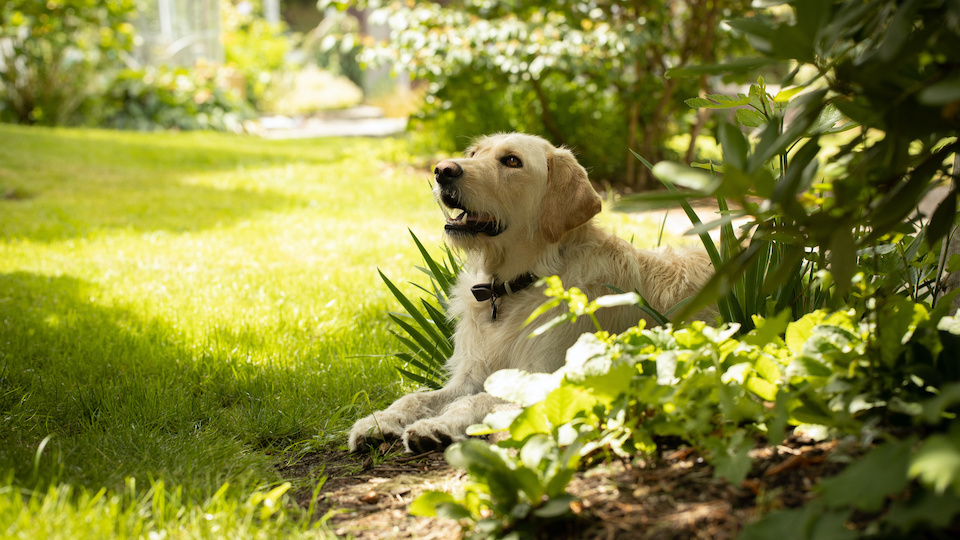Chowing down on any plant material may cause gastrointestinal upset and vomiting for your dog. But some plants, when ingested, can be life-threatening. Certain herbs, vegetables and edible plants that are perfectly fine for human consumption could cause everything from excessive drooling to anorexia for your canine pal. Don’t assume that dogs instinctively avoid dangerous plants. That may be true of some animals in the wild, but dogs have no way of distinguishing between safe and unsafe plants. The following is a list of common plants that could be dangerous for your dog. So, don’t ever plant these if you share your yard with a canine friend.
Chamomile (Anthemis nobilis)
This soothing herb may smell lovely and make a great cup of tea, but it is also toxic for dogs. Possible symptoms, according to ASPCA, include vomiting, diarrhea, contact dermatitis, allergic reaction, anorexia, and bleeding tendencies after long-term ingestion.
Chives (Allium schoenoprasum)
Chives belong to the Allium family, which includes onions and garlic. All of these can be very harmful to your dog when eaten. Low doses may be tolerable, but it is best to avoid planting these herbs whenever possible.
Possible symptoms, according to Pet Poison HelpLine, include nausea, drooling, vomiting, diarrhea, and oral problems such as pale gums. Symptoms may also include lethargy, weakness, collapse, intolerance to exercise, elevated heart rate and respiratory rate, and abdominal pain.
Garlic (Allium sativum)
Like chives, garlic poses a threat to your dog and can be mildly to moderately dangerous. Garlic is five times more toxic than onions, according to the Pet Poison Helpline. Regardless, dogs still love the taste and could chow down, making themselves ill.
Possible symptoms include nausea, vomiting, diarrhea, drooling, pale gums, lethargy, weakness, abdominal pain, elevated heart rate and respiratory rate, intolerance to exercise, and collapse.
Onions and Shallots (Allium cepa) (var. aggregatum)
Onions are a staple in many gardens; however, when it comes to your dog, caution is needed, as these pose a toxic problem for pets, according to the Pet Poison Helpline.
Possible symptoms include vomiting, diarrhea, nausea, lethargy, abdominal pain, elevated heart rate, and respiratory rate, drooling, oral irritation, weakness, exercise intolerance, collapse, and pale gums.
Leaks (Allium ampeloprasum)
Here’s another popular member of the Allium family. Leeks are not dog-friendly and may cause some excruciating symptoms for dogs.
Possible symptoms, according to Pet Poison HelpLine, include nausea, drooling, vomiting, diarrhea, oral problems, lethargy, weakness, collapse, intolerance to exercise, elevated heart rate and respiratory rate, and abdominal pain.
Marijuana (Cannabis genus)
With the legalization of marijuana (medicinally and recreationally) in many states, some have chosen to grow it. But make sure your dog does not ingest the marijuana plant or even dried cannabis, as it could potentially lead to death. According to the ASPCA, symptoms could be mild to severe or even deadly.
Possible symptoms include vomiting, incoordination, prolonged depression, sleepiness or excitation, hypersalivation, low blood pressure and body temperature, dilated pupils, seizure, coma, and rarely, death.
Rhubarb (Rheum rhabarbarum)
Rhubarb grows in early spring. While it might be delicious in baked goods, it can wreak havoc on your puppy’s urinary tract according to Pet Poison Helpline.
Possible symptoms include loss of appetite, drooling, tremors, vomiting, diarrhea, lethargy, weakness, blood in urine, and changes in thirst and urination.
Tomatoes (Solanum lycopersicum)
Juicy tomatoes are a staple in most gardens. But as a member of the nightshade family, tomato vines and leaves can be toxic for dogs.
Possible symptoms, according to the ASPCA, include, loss of appetite, depression, hypersalivation, severe upset stomach, diarrhea, drowsiness, confusion, weakness, behavioral change, dilated pupils, and a slow heart rate.
Autumn Crocus (Colchicum autumnale)
Unlike the more common spring Crocus, the autumn crocus causes severe gastrointestinal upset, respiratory or kidney failure, and even death, according to the Pet Poison Helpline. While the spring Crocus can still cause an upset stomach, symptoms are typically mild.
Possible symptoms include vomiting, diarrhea and bloody diarrhea, drooling, loss of appetite, black, tar-like stool, organ damage, respiratory failure, seizures, and death.
Begonia (Begonia genus)
Begonias are extremely popular as an outdoor and indoor plant. However, if ingested, these plants could cause a lot of problems for your dog, according to the ASPCA.
Possible symptoms include irritation to the mouth with a strong burning sensation and irritation of lips, tongue, and mouth, excessive drooling, vomiting, and difficulty swallowing.
What to do if you suspect your dog has eaten a poisonous plant
This is just the tip of the iceberg. There are many more plants, shrubs, and trees that can pose a threat to your pooch. Survey your garden, take notes, and do a little research. If you suspect your dog has eaten a poisonous plant, call your veterinarian immediately. In addition, the American Kennel Club (AKC Vetline) has a vet line that supplies 24/7 access to trained pet care professionals and licensed veterinary staff who can help you with questions about poisoning. Your garden can be full of surprises — good and bad. Protect your pet.
-Katherine Marko



